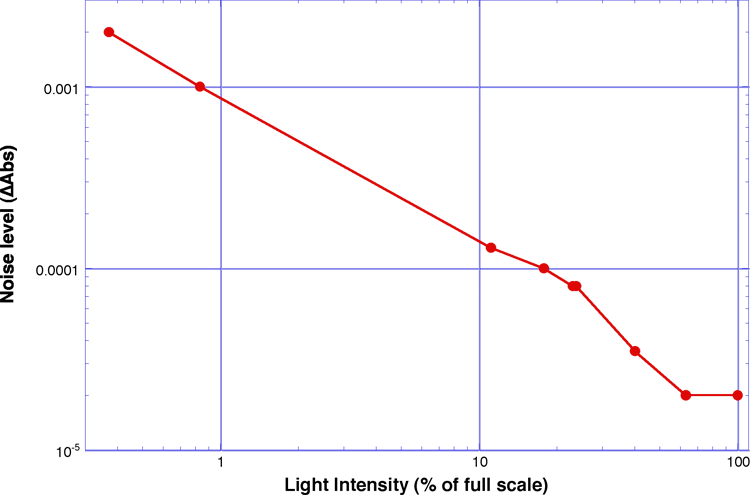Improvement of signal-to-noise by averaging.
Usually a single ∆abs measurement does not give sufficiently good data. Therefore, the measurement is repeated many times and averaged. This improves the signal-to-noise ratio proportional to the square root of the number of measurements. It also means that, if the signal-to-noise ratio of a single ∆abs measurement can be improved by a factor of 10, the needed instrumentation time to measure a kinetic trace can be reduced by a factor of 100. Two procedures for averaging have been implemented: the “scan” and the “sweep” mode.
In the scan mode the delay line moves to the first time point and a given number of ∆abs measurements are performed. By repeating this procedure for all the time points a complete scan of the kinetic trace is collected. This scan procedure is then repeated until an appropriate signal-to-noise ratio is obtained. In the sweep mode, the delay line moves over the whole time window of interest at constant speed. The ∆abs measurements are performed at successive time points, collecting a complete kinetic trace in each sweep. The sweep is then repeated for averaging purpose. A sweep is also collected when the delay line is moving backward. In the sweep mode, the pump pulse fluctuations are generally averaged out better than in the scan mode.
With the CPA-2001/OPA (Clark-MXR Inc) laser set-up at Chemical Physics, Lund University, we have achieved noise levels of better than 2.10-6 ∆abs (one standard deviation) after averaging 1000 times (2000 laser pulses or 2 seconds, single wavelength measurements without pump pulse and empty sample holder). This noise level has been difficult to maintain in real measurements, using normal cuvettes, which scatter light more than high quality optics, but noise levels of a factor of 4 higher are readily achieved. With the diode array detector, using spectrally broadened probe pulses (OPO amplified continuum, ~100 nJ per pulse, see fig 9), a noise level of 2.10-5 per channel was obtained for the part of the array (~200 diodes, ~100 nm) with the highest light intensity (see fig 7). If continuum is used as probe light the light intensity is significantly lower and the noise increases correspondingly. Likewise, at high continuum light levels the uncertainties in the polarisation give rise to increasing noise levels. With white light, generated at 800 nm, noise levels better than 2.10-3 per channel over the entire array, covering from 480 to 750 nm, have been obtained.

Noise level for the diode array versus probe light intensity after averaging 1000 times.
|



